Sabot and Stability System
A useful method of distinguishing artillery projectiles is by grouping them according
to the sabot or stabilizing systems they employed. In order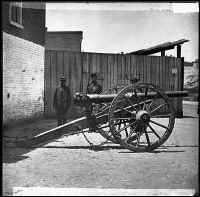 for the sabot or stabilizer to
function properly, the cannon tube needed to be rifled in the familiar land and groove
pattern. Some systems had their own distinctive pattern, such as the Whitworth cannon tube. Historically, nine different
major stabilizing systems saw use during the Civil War.
for the sabot or stabilizer to
function properly, the cannon tube needed to be rifled in the familiar land and groove
pattern. Some systems had their own distinctive pattern, such as the Whitworth cannon tube. Historically, nine different
major stabilizing systems saw use during the Civil War.
(1) The most common system employed was developed by Dr. John B. Read. Closely resembling Read's system was the one used by Robert P. Parrott. In both variations when the cannon was fired, the force of the explosion caused a ring of soft metal attached to the base of the projectile to expand into the spiral grooves of the tube. This imparted a rotary motion to the projectile. The expansion ring was commonly made of wrought iron, brass, copper, or lead. Projectiles using this system can be found here.
(2) The
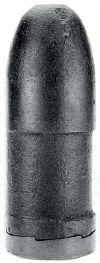 second system consisted of a curved, or cupped plate, commonly made of brass,
copper, or lead, secured to the projectile by a central screw or bolt. The plate was held
firm by either a system of radial grooves in the iron projectile base or by three copper
projections from the plate extending from the plate into holes in the base of the
projectile. The plate could also have three or more iron pins protruding from the base of
the projectile through holes in the plate. The rifled motion was imparted to the
projectile when the cannon detonation flattened the plate. This forced it into the grooves
of the artillery tube by increasing its caliber. Projectiles using this system type
include the Mullane or Tennessee sabot and
Brooke ratchet sabot.
second system consisted of a curved, or cupped plate, commonly made of brass,
copper, or lead, secured to the projectile by a central screw or bolt. The plate was held
firm by either a system of radial grooves in the iron projectile base or by three copper
projections from the plate extending from the plate into holes in the base of the
projectile. The plate could also have three or more iron pins protruding from the base of
the projectile through holes in the plate. The rifled motion was imparted to the
projectile when the cannon detonation flattened the plate. This forced it into the grooves
of the artillery tube by increasing its caliber. Projectiles using this system type
include the Mullane or Tennessee sabot and
Brooke ratchet sabot.
(3) The third system employed a soft band of lead, as in the Hotchkiss projectile or a
papier-mâché' cylinder,
as in the Schenkl projectile. These sabots
were forced into the grooves by expansion as they were pushed forward along the tapered or
cone portion of the projectile by the force of the propellant gases.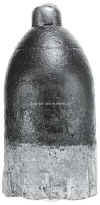
(4) The fourth system was exemplified by the Britten and Dyer projectiles. A lead cup enclosed the projectile base and extended a varying distance up the body of the projectile. This method of attaching the sabot was the invention of Bashly Britten of England, and was patented by him, dated March 17, 1855, British patent #604.
(5) The fifth system, also of British origin, was developed by Sir. William G.
Armstrong. An example is the Armstrong projectile.
This projectile had to be fired from a specially designed cannon tube. The system
consisted of two or more rows of metal studs that projected from the body of the
projectile. These studs fit into the deep side of the angled grooves of the cannon tube.
When the firing charge was detonated, the projectile shifted to the less distinct portion
of each groove that compressed the studs. These studs helped the projectile to take the
rifling during discharge.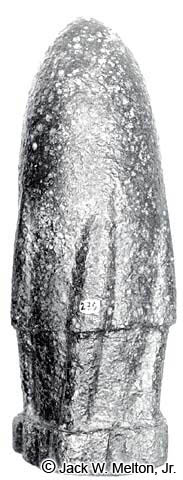
(6) The sixth system was similar to the Armstrong design but it used flanges instead of studs. The projectile had two or three long vertical iron ridges that corresponded to the rifling of the cannon tube. The Pattison and Blakely projectile employed this system.
(7) The seventh system fitted a bore-shaped projectile with a cannon tube.
Sir Joseph
Whitworth and Theophilus Blakely were two pioneers in the development of this system. The
exterior of the projectile and the interior of the cannon bore corresponded with each
other. The projectile was the exact shape of the cannon bore, minus windage. Both
breech-loading and muzzle loading cannon employed this system. The Whitworth and the flanged Blakely projectiles are examples that
used this system.
(8) The eighth system is another of the British design. It employed a breech-loaded projectile that had a diameter slightly larger than the bore of the cannon. The sabot was compressed into the grooves of the rifling upon discharge. The lead covered Armstrong projectile is an example that employed this system.
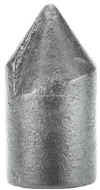 (9) In the ninth system, the projectile body had raised and/or depressed areas on the
base or nose angled to cause rotation. This system was used in smoothbore cannon that
fired conical projectiles. The Carkeet projectile is an example of a projectile that used
this system. Another variation of this system is noted in the wing shot . It used
spring-loaded air vanes which were intended to aid its stability in flight.
(9) In the ninth system, the projectile body had raised and/or depressed areas on the
base or nose angled to cause rotation. This system was used in smoothbore cannon that
fired conical projectiles. The Carkeet projectile is an example of a projectile that used
this system. Another variation of this system is noted in the wing shot . It used
spring-loaded air vanes which were intended to aid its stability in flight.